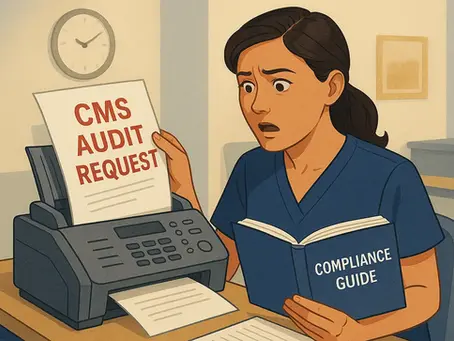top of page
Blog: Blog2

Shared Health Services Blog
Welcome to the Shared Health Services blog—a resource designed for hospitals and physician practices exploring outpatient wound care and hyperbaric medicine. We provide a proven framework, clinical expertise, and personalized support to help you launch and manage successful, branded programs that reflect your identity and meet your community’s needs.
Search


Compliant Documentation Is Storytelling — Here’s Why It Matters
Great documentation is more than compliance — it’s storytelling. In wound care and hyperbaric oxygen therapy (HBOT), every patient record should read like a clear, defensible narrative. From proving HBOT candidacy to building treatment plans and tracking outcomes, each act in the story builds trust, supports reimbursement, and captures the real work happening in the treatment room.
Aug 1512 min read


From Pressure to Possibility: What 2025 Drug and Policy Shifts Mean for Wound Care Programs
From pricing reform and rebate pilots to direct-to-patient drug access and rural funding, hospitals are facing rapid shifts in how cellular and/or tissue-based products (CTPs) are purchased, reimbursed, and documented. This post breaks down what wound care leaders need to know — and how Shared Health Services helps partners respond with insight, compliance support, and tools that strengthen long-term strategies.
Aug 67 min read


Medicare at 60: A New Chapter for Hospitals — and a Fresh Opportunity for Wound Care Programs
On July 30, 1965, Medicare and Medicaid became pillars of access and equity in U.S. health care. Sixty years later, they support over 140 million Americans — including many patients seen in hospital-based wound care and hyperbaric programs. This post explores their legacy, outlines key CMS updates for FY 2026, and shows how Shared Health Services equips partners to respond to policy change with confidence, clarity, and compliant care delivery.
Aug 15 min read


When Care Isn’t the Problem: What Social Holds, Homelessness, and Policy Shifts Mean for Hospital Capacity
When patients have nowhere to go, hospitals are left holding the line — often at the expense of reimbursement, staffing, and patient care. This post unpacks the hidden costs of social holds, how they distort LOS metrics, and what it means for wound care teams managing complex patients in overcrowded systems. Learn how Shared Health Services equips partners to stay focused on healing while navigating today’s discharge challenges.
Jul 316 min read


Why NFPA 99 Compliance Is Essential for Safe Hyperbaric Programs
Hospitals and physician practices launching a wound care and hyperbaric oxygen therapy (HBOT) program must meet NFPA 99 standards from day one. This post breaks down critical Chapter 14 requirements—including safety the hyperbaric coordinator role, chamber classifications, fire protection systems, electrical guidelines, and survey readiness—and explains how SHS supports partners in building compliant, high-performing HBOT programs that reduce risk and deliver lasting value.
Jul 284 min read


ACA Lawsuit, Medicaid Tensions, and the Road Ahead for Rural Hospitals
A new CMS rule may lead to 1.8 million people losing health coverage — putting pressure on hospitals to manage eligibility shifts, Medicaid changes, and access barriers. But for rural wound care programs, this is also a chance to close gaps, streamline referrals, and build resilience. Learn how SHS supports partners with smart, site-specific tools that simplify workflows, protect patient access, and strengthen financial sustainability.
Jul 235 min read


Hyperbaric Oxygen Therapy Safety: Why Oversight Matters
In 2025, two tragic HBOT incidents at wellness clinics reignited concern across the field. This post explores the risks of non-clinical hyperbaric use, highlights what truly makes HBOT safe, and outlines the standards SHS champions for hospital- and physician-practice-based programs. If your team is re-evaluating protocols, credentials, or training, this is a must-read guide to safety, clarity, and clinical oversight.
Jul 184 min read


CMS Proposes Major Reimbursement Shifts for Skin Substitutes and Outpatient Services in 2026
CMS’s proposed 2026 OPPS rule could significantly impact wound care reimbursement, including major shifts for skin substitutes and outpatient services. This post breaks down what’s changing, what’s uncertain, and how Shared Health Services equips hospital leaders to stay ahead. Get clear insights and strategic takeaways to help your team prepare now.
Jul 175 min read


What the One Big Beautiful Bill Means for Wound Care and Rural Hospitals
Signed into law on July 4, 2025, the One Big Beautiful Bill offers real funding and reform opportunities for rural hospitals and wound care programs. From $50B in transformation grants to Medicare pay increases and broadband expansion, here’s what rural leaders need to know — and how SHS is helping partners act.
Jul 74 min read


The Skin Subs Crackdown: Federal Indictments and the Future of CTP Reimbursement
The DOJ just indicted providers in one of the largest skin sub fraud schemes ever—and CMS is launching a new prior auth model targeting wound care. If your program uses cellular and/or tissue-based products (CTPs), now is the time to tighten documentation and revisit patient selection protocols. This blog breaks down what’s changing—and how SHS helps wound centers deliver compliant, audit-ready care.
Jul 23 min read


Home-Acquired Pressure Injuries: Will They Become Serious Reportable Events?
A new proposal under review by the National Quality Forum could classify pressure injuries that develop at home as Serious Reportable Events (SREs). While not yet mandated, this shift may affect how wound centers document, report, and respond — especially under programs like MIPS. SHS breaks down what this could mean, how to prepare, and why your voice matters in the national comment period.
Jun 303 min read


Don’t Fax That Back: How to Spot Medicare Audit Phishing Scams
CMS has issued a fraud alert warning healthcare providers about scammers posing as auditors and sending fake fax requests for medical records. Wound care clinics are frequent targets due to high Medicare volume and audit activity. Learn how to spot a phishing attempt and what steps to take to protect your patients, your data, and your compliance standing.
Jun 272 min read
bottom of page


